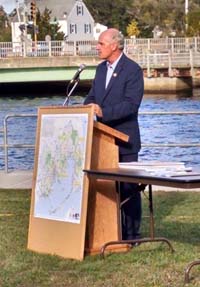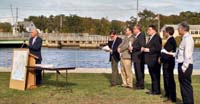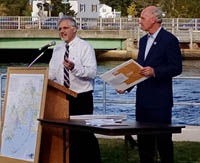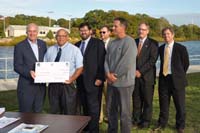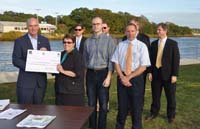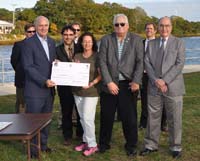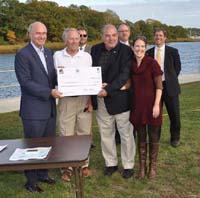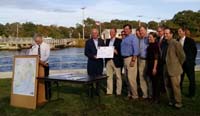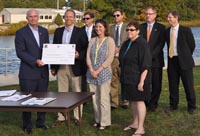Coastal Watershed Restoration Program Funding for 2015
The United States Environmental Protection Agency's (U.S. EPA) Southeast New England Program ("SNEP") has a long-term agenda that includes the protection, enhancement, and restoration of clean water, healthy diverse habitats, and associated populations of fish, shellfish, and other aquatic dependent organisms. In federal fiscal year 2015, the U.S. EPA received $5 million in support of the SNEP initiative.
The first release of funds was up to $1.5 million to be released through EPA New England's Healthy Communities Grant Program, according to this 2015 application guidance. Applications were submitted through Grants.Gov. The deadline for pre-proposals for Healthy Communities was April 30, 2015. Proposals up to $200,000 were considered, and a 5% match is required. Healthy Community SNEP grants will be announced in the fall of 2015.
In July 2015, the Buzzards Bay and Narragansett Estuary Programs issued RFPs to enable the award of $1.8 million ($900,000 each)in an NEP 2015 Water Quality Management Grant round. Projects that address fresh or marine water quality degradation from nutrients (phosphorus or nitrogen), pathogens, and stormwater will be considered. Go to our Grant Information page for updates and more information.
The remainder of the funds will be issued by EPA through various grants and contracts.
Coastal Watershed Restoration Program Funding for 2014
In 2014, the U.S. EPA provided $2,000,000 for grants in support of this initiative. On October 15, 2014, the Buzzards Bay NEP awarded $728,559 in 6 grants in support of the Southeast New England Program.
Funding Priorities for 2014
In the first year of funding, the Coastal Watershed Restoration Program focused on the critical issue of nutrient pollution (both nitrogen and phosphorus loadings) to waters and habitat listed or documented as impaired.
Excessive nutrient inputs can result in increased growth of microalgae (such as phytoplankton) and macroalgae (seaweeds), which in turn changes the distribution and abundance of species present and in food web relationships. In marine waters, increased turbidity from phytoplankton growth prevents sunlight from reaching submerged vegetation like eelgrass, and beds of eelgrass begin to disappear. Because eelgrass beds are a valuable habitat and nursery for many organisms, the loss of this community can cause shifts in many populations of animals. Excessive algal growth, coupled with decay of accumulated algae, may result in the depletion of oxygen in the water. Depressed oxygen concentrations (anoxia or hypoxia) can lead to fish kills and death of sensitive benthic organisms. Similar adverse effects may occur in freshwater systems.
Nutrient pollution can be caused by wastewater sources such as treatment plants, combined sewers, on-site septic systems, and cesspools. Other locally important controllable sources and conveyances can include fertilizer inputs on lawns, agricultural lands, and golf courses, stormwater discharges, animal wastes on farms, and landfills to name a few. In many watersheds, the relative contribution of sources have been identified through the development of reports in support of TMDLs (see www.oceanscience.net/estuaries). When site-specific solutions are proposed, they must address source loading estimates in draft or final TMDL studies wherever available. More details about nitrogen loading impacts and possible solutions can be found in the Buzzards Bay Comprehensive Conservation and Management Plan 2013 Update (CCMP), Chapter 3: Characterization of Pollution Sources and Action Plan 1: Managing Nitrogen Sensitive Embayments.
2014 Awards
On Wed. Oct. 15, 2014 U.S. Environmental Protection Agency (EPA) Regional Administrator Curt Spalding travelled to Wareham, Mass. to meet with state and local officials to announce and kick off this new collaborative effort to protect water quality, habitat, and coastal environments in southeast coastal New England. Particpants included Curt Spalding, Regional Administrator, U.S. EPA; U.S. Congressman Bill Keating; MA Senator Marc Pacheco; David Cash, Commissioner, Massachusetts DEP; Bruce Carlisle, Director, Mass. Office of Coastal Zone Management; Joe Costa, Director, Buzzards Bay National Estuary Program; and Peter Teitelbaum, Selectman, Town of Wareham who made welcoming remarks.
The following projects were announced as funded in the Buzzards Bay watershed:
Gypsum as a Phosphorus and Sediment Control Agent in Cranberry Floodwaters
$98,346 - University of Massachusetts, Amherst. The goal of this project is to develop a management practice to control phosphorus in the discharges of cranberry bog harvest floodwaters. When discharged to surrounding surface waters, phosphorous can cause water quality degradation by promoting excessive plant growth and reduced oxygen supplies. Gypsum and sulfur will be used to lower dissolved phosphorus in freshwater lakes and ponds, and research will be conducted to identify the most effective approach to its use.
Nitrogen Reduction Pilot Study at the Fairhaven Municipal Water Pollution Control Facility
$90,000 - Town of Fairhaven. The Town of Fairhaven will evaluate several modifications to its wastewater treatment processes to reduce nitrogen concentrations at the Water Pollution Control Facility to meet new requirements. A pilot study will be conducted at the plant to provide a framework for design and construction of new nitrogen reduction facilities.
Process Monitoring for Optimal Nitrogen Treatment and Outfall Reduction
$75,000 - Town of Wareham, Wareham Water Pollution Control Facility. This project seeks to further reduce nitrogen discharges from the Wareham Water Pollution Control Facility to the Wareham River estuary through the installation of state-of-the-art nitrogen monitoring equipment and process controls. A computerized network of monitoring probes will be installed to collect data in real time. This data will allow immediate corrections to be made to the various treatment processes before problems arise and will help ensure that the treatment process is maintained in an optimal state for nitrogen removal.
Red Brook Harbor Restoration - A Public-Private Partnership
$50,000 - Buzzards Bay Coalition. Red Brook Harborview is a planned 15-townhouse development located in Cataumet Village in Bourne. When the development is constructed, it will include a neighborhood-scale private wastewater treatment facility, which is required by the Town to have excess capacity to allow for connections from the Kingman Yacht Center and other neighborhood properties. Through this project, sewer plans will be developed to tie in the neighboring 52-home Cedar Point development, which will eliminate Title 5 systems and cesspools that are degrading water quality. A legal entity will also be developed that can apply for state and federal financing to pay for the connections of the homes to the new wastewater treatment facility.
Reducing Nutrient Releases from Cranberry Bogs
$165,213 - Buzzards Bay Coalition. Nutrient discharges from cranberry bogs to groundwater and surface waters are a potential source of nitrogen pollution to coastal waters and phosphorus pollution to freshwaters. There is often uncertainty as to what loading rates to assign to cranberry bogs in nitrogen loading models to coastal watersheds used to establish nitrogen total maximum daily loads. The Buzzards Bay Coalition, in partnership with the Marine Biological Laboratory and the University of Massachusetts Cranberry Experiment Station, will study the release of nitrogen and phosphorus from cranberry bogs to better understand these nutrient loadings. This data will provide a better understand of actual nutrient release from cranberry bogs, which can be used to develop management plans to reduce nutrient pollution.
West Falmouth Harbor Shoreline Septic Remediation Project
$250,000 - Town of Falmouth. To meet water quality standards for West Falmouth Harbor, the Town of Falmouth, in partnership with the Buzzards Bay Coalition, will encourage the replacement of existing Title 5 septic systems or cesspools on properties located within 300 feet of West Falmouth Harbor with innovative alternative nitrogen removing septic systems or eco-toilets (composting or urine-diverting systems). The Town and the Coalition will work with the West Falmouth Village Association to secure commitments from property owners and provide grants to homeowners of up to $10,000 to upgrade their systems. Grant funds will also be used to monitor the performance of the installed systems.
Event Remarks
The PA system failed during a portion of Buzzards Bay National Estuary Program Executive Director Joe Costa's remarks. Below we provide the prepared remarks describing the projects.
This year's grant program focused on addressing degradation of water quality and habitat caused by both nitrogen discharges to coastal waters and phosphorus discharges to freshwaters. In this part of Buzzards Bay, cranberry bogs are one of the sources of phosphorus to freshwaters through the release of floodwaters.
In our first grant award, Dr. Carolyn DeMoranville of the University of Massachusetts, Amherst Cranberry Experiment Station has teamed up with the Dr. Casey Kennedy of the U.S. Department of Agriculture, Brian Wick of the Cape Cod Cranberry Growers' Association, and two cranberry bog operators near White Island Pond in Wareham (Walter Morrison III, Federal Furnace Cranberry and George Rogers, A.D. Makepeace). White Island Pond is a water body impaired by phosphorus and subject to a phosphorus total maximum daily load limit. For their project titled Gypsum as a Phosphorus and Sediment Control Agent in Cranberry Floodwaters, the UMass Cranberry Experiment Station will receive $98,346. The goal of the project is to develop a procedure of adding a natural mineral called gypsum to cranberry bog floodwater to bind and capture that phosphorus within the bog system so it is not released to rivers and ponds. The study will establish the dosage and timing of Gypsum additions to maximize the benefits of this new proposed practice. This practice will have applicability to the 1000s of acres of cranberry bogs across our watershed.
Municipal wastewater facilities are often large contributors of nitrogen loading in some embayments in Buzzards Bay. Here in Wareham, in our second project, the Town of Wareham Water Pollution Control Facility complies with their wastewater discharge permit that limits nitrogen to a seasonal average of 4.0 ppm. This discharge permit, when issued about 2001, was the first of its kind in Massachusetts and remains one of toughest discharge permits. Guy Campinha, Director of Water Pollution Control thinks he can do better. As part of a proposal titled Process Monitoring for Optimal Nitrogen Treatment and Outfall Reduction, for $75,000, the wastewater facility will install a computerized monitoring tracking system with monitoring probes throughout the facility tanks and channels to optimize the process, further reducing discharge concentrations by 0.5 to 1-ppm that will result in the reduction of thousands of pounds of nitrogen when the plant reaches full capacity.
Many municipalities have adopted local bylaws to maximize the benefits of new development. In one town, Bourne, they adopted a marina overlay district bylaw to allow certain developments in exchange for sewering of private homes on septic systems. However, even with a bylaw like Bourne's in place, sewer lines do not magically grow underground. They require a legal structure, plans, and financing. They also do not always have to be built by local government. In the Red Brook Harbor Restoration - A Public-Private Partnership, the Buzzards Bay Coalition, with a $50,000 grant, is working with Bourne property owners, Kingman Yacht Center, and Horsley Witten Group to develop sewer plans and establish the legal structure necessary to seek state and federal funds to tie in homes in the Cedar Point area into a private wastewater facility to eliminate septic systems contributing to water quality degradation in Red Brook Harbor.
In our first grant, I told you that cranberry bogs could be an important contributor of phosphorus to freshwater. Well they can be a locally important source of nitrogen to coastal waters as well. It turns out that the release of nitrogen from bogs to surface waters and ground water is complex, and varies with the types of berries grown, how water is managed on bogs, and the timing and types of fertilizer used. The Buzzards Bay Coalition has put together a collaboration between scientists in Woods Hole led by Dr. Chris Neill of the Ecosystems Center of the Marine Biological Laboratory, together with Dr. DeMoranville of the Cranberry Experiment station, and Dr. Rachel Jakuba of the Buzzards Bay Coalition, and with the participation of 6 bog owners across the region to study these pathways and nutrient releases. In a proposal titled Reducing Nutrient Releases from cranberry Bogs, for $165,213. Scientists and managers will evaluate nitrogen pathways and develop recommendations for grower practices to reduce discharges of nitrogen from Cranberry bogs, and develop better estimates of loading factors to be used in watershed nutrient loading models.
In our award to Wareham, the Town was fine-tuning the performance of their advanced nitrogen removal wastewater facility. The Town of Fairhaven does not currently have a wastewater facility designed to remove nitrogen, but they are being required to do so. When you have an existing wastewater facility, you modify it in ways, and with new processes to reduce nitrogen concentrations. There are a number of options and strategies to pursue. For a $90,000 grant, developed by Fairhaven Wastewater Superintendent Linda Schick, the Town will undertake a Nitrogen Reduction Pilot Study to find out what approach works best. This study will set the stage for a redesign of the wastewater facility. When the facility is finally upgraded, nitrogen loading to New Bedford inner harbor will be reduced by more than 100,000 pounds annually. This grant is the first step toward that outcome.
Some towns, like Falmouth, are already proceeding with plans to expand sewering to reduce nitrogen loading to coastal embayments polluted by septic system discharges. However, under planned sewer expansion, there are areas of the Town that will not be sewered. This includes some areas close to the shores of West Falmouth Harbor. In a $250,000 award to the Town of Falmouth for a proposal titled West Falmouth Harbor Shoreline Septic Remediation Project, the Town under the leadership of Wastewater Superintendent Gerald Potamis, will implement a grant incentive program to encourage homeowners to replace existing onsite wastewater system within 300 feet of West Falmouth Harbor. West Falmouth Harbor is subject to a watershed nitrogen TMDL limit. The existing systems will be replaced with advanced nitrogen removing onsite systems or eco toilets. The Town is collaborating with the West Falmouth Village Association, Barnstable County Health, and the Buzzards Bay Coalition in this effort. Not only will the effort compliment the Town's planned sewer expansion, it will give more immediate benefits to water quality because of the short travel time of the onsite system discharges close to shore.

